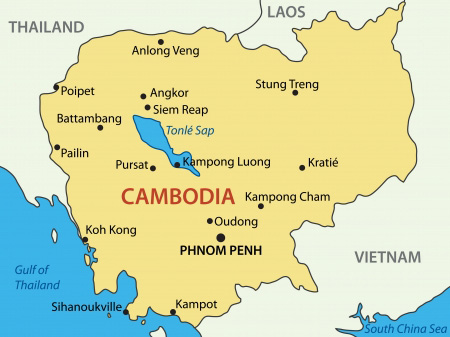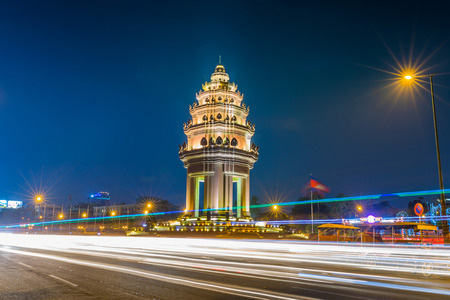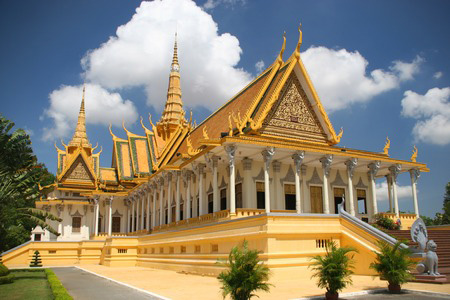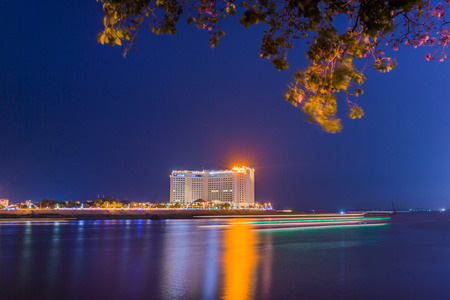Reading Comprehension Text and Exercises
Phnom Penh,
Capital of Cambodia
Big cities show the heart of a country. When people think of France, they often see Paris in their minds. Paris is a symbol of the delicious food and high fashion that is the heart of France. In the same way, Phnom Penh is the heart of Cambodia.
Phnom Penh is a symbol of the triumphs and the tragedy of Cambodian history. This important city also shows the growing self-confidence of the Cambodian people as they showcase their culture, historical monuments, and Buddhist heritage for world visitors.
Click Here for Step-by-Step Rules, Stories and Exercises to Practice All English Tenses
Facts about Cambodia

Cambodia is a country in Southeast Asia. Cambodia borders Laos, Thailand, and Vietnam. The Cambodian coastline runs along the Gulf of Thailand. The major language of Cambodia is Khmer. Its major religion is Buddhism. Cambodia was ruled by France, but it became a free nation in 1953. In the 1970s the country went through a violent period under the Khmer Rouge, a communist political group. Now Cambodia is at peace and working to make life better for its people.
The Basics of Phnom Penh
Phnom Penh sits in the southern half of Cambodia at the intersection of three rivers. It is the biggest city in the country with more than one million people. It is also the capital of Cambodia. Many important cultural, religious, and historical sites are here.
Attractions
One historical site that is popular with locals and tourists is Independence Monument. This monument commemorates the time that Cambodia became independent from France. It also honors the people who died in the war for independence. The Cambodian Architect Vann Molyvann built the monument as a lotus flower.

The reddish brown monument stands about 20 meters tall. At night, blue, red, and white lights shine on the monument. Blue, red, and white are the colors of the Cambodian flag. The people hold festivals around the monument to celebrate holidays such as Independence Day and Constitution Day.
The Royal Palace is a political and religious attraction in Phnom Penh. The Royal Palace is the home of the King of Cambodia. Tourists can find the sacred Emerald Buddha here as well. The Emerald Buddha is a seventeenth century statue made of beautiful green crystal.

Royal ceremonies take place at the Palace. Gifts from other countries line its walls. The Palace also has a 600 meter mural (a picture painted on one of its walls). The mural shows a popular religious story.
The Center of Cambodian Buddhism is another attraction in Phnom Penh called Wat Ounlom. This ancient shrine, built in 1443, holds the eyebrow hair of Lord Buddha. At one time 500 monks lived at the shrine.
The Khmer Rouge killed many monks and tried to destroy the shrine, but they did not succeed. The eyebrow hair was saved, and the shrine continues to be an important religious symbol.
The Museum of Genocide tells about the suffering caused by the Khmer Rouge communist party. The museum used to be a high school. The Khmer Rouge made the high school into a prison in the 1970s. Those who were against the Khmer Rouge were tortured and killed here. Visitors can see how prisoners lived and hear stories from survivors of the prison.
Dining in Phnom Penh
Tourists can enjoy street food made by locals or choose one of the gourmet restaurants in the city center. Locals and tourists love fish amok, a true example of Khmer street food. Fish amok is a dish that mixes spices with fish and coconut curry. It is a favorite snack food.
Phnom Penh has many fancy restaurants too. Romdeng is a gourmet restaurant that has a social mission as well. The restaurant serves authentic Cambodian foods and trains poor Cambodian children in the art of food service.
Other Things to Do in Phnom Penh
Visitors who want excitement can take a Tuk-Tuk taxi tour. A Tuk-Tuk taxi has three wheels. It is perfect for zipping around the popular tourist sites of the city. The drivers are expert guides and give a personal and fun experience of the city.
A more relaxing way to see the country is a cruise on the Mekong River. Away from the energy of the city center, you can hear and see the slower pace of life along the banks of the river. Farmers work in their rice fields and raise fish in their fish farms. Local silk weavers show their crafts. The natural beauty of the river is all around you.

Comprehension Exercises
Vocabulary Questions
- What does "zipping" mean?
- to go very slow
- to go very carefully
- to go very fast
- What does "gourmet" mean?
- high quality, expensive food
- good, cheap food
- local food only
- What does "prison" mean?
- a place where people work
- a place where we keep important objects
- a place where people stay and cannot leave as a punishment for a crime
- What does "shrine" mean?
- a place that holds holy objects
- a place that holds political objects
- a place that holds gourmet food
- What does "mural" mean?
- a religious story
- a painting on a wall
- a type of sport
Wh Questions
- Where is the eyebrow hair of the Lord Buddha?
- The National Museum of Genocide
- The Royal Palace
- Wat Ounlom
- When did Cambodia become independent from France?
- 1443
- 1953
- The seventeenth century
- Why is the Tuk-Tuk taxi a fun way to see Phnom Penh?
- The taxi can zip around the city.
- The taxi is cheap.
- The taxi is pretty.
- Who lives in the Royal Palace?
- The president of Cambodia
- The prime minister of Cambodia
- The king of Cambodia.
- How many people live in Phnom Penh?
- More than one million
- Less than one million
- Two million
Evaluating Statements
- Based on the information in this lesson, which statement is true?
- Phnom Penh shows only the political heritage of Cambodia.
- Phnom Penh shows only the importance of Buddhism to Cambodia.
- Phnom Penh is the capital of Cambodia.
- Based on the information in this lesson, which statement is false?
- The Independence Monument was designed by a Cambodian architect.
- The Independence Monument is 30 meters tall.
- The Independence Monument is used for festivals.
True or False?
- Based on the information in this lesson, is the following statement true or false?
"A tourist cannot hear stories from people who lived at the prison at the National Genocide Museum."
- true
- false
- Based on the information in this lesson, is the following statement true or false?
"The Khmer Rouge tried to destroy the shrine Wat Ounlom." - true
- false
Answer Key
1. C | 2. A | 3. C | 4. A | 5. B | 6. C | 7. B | 8. A | 9. C | 10. A | 11. C | 12. B | 13. B | 14. A
Get Updates, Special Offers, and English Resources
Download your FREE GIFT (the first two chapters of
English Short Stories Book and Workbook)
as soon as you join!

By submitting your email, you consent to receiving updates and newsletters from us and to the sharing of your personal data with third parties for the purposes of sending you communications. We will not spam you. You can unsubscribe at any time. For more information, please see our privacy policy.





